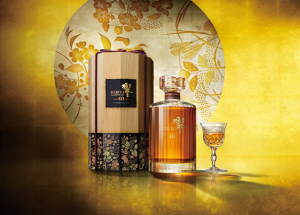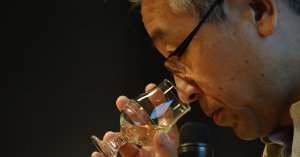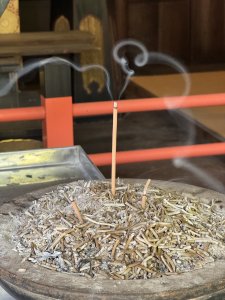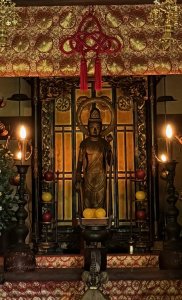Hibiki 40-year-old

How do you approach making a 40 year old blend? Even before you start, there are built-in restrictions. The stock you can draw from will be, inevitably, limited. The whiskies have to have spent at least four decades in cask. Time and wood does interesting things to whisky, not always to the spirit’s benefit.
Little surprise that many blends of this age have an element of compromise about them. Old whiskies, flirting with astringency and the sense of imminent collapse.
But this was Hibiki. Created by Koichi Inatomi in 1987 for many, myself included, it is the pinnacle of Japanese whisky-making.
Hibiki spans the fragrance of Japanese Harmony, the fruited depth of 17-year-old, the incense and scented woods of 21-year-old, and rich dark and dried orchard fruits of the subtly powerful 30-year-old. Each iteration adds more layers and depth, extra levels of complexity.
Logically, a 40-year-old would be the next step in that progression, but Suntory’s chief blender, Shinji Fukuyo, went in the opposite direction.
‘It was a challenge,’ he says with a smile, ‘as the 30-year-old was seen as being the peak. I wanted elegance, transparency. Whiskies at their peak of maturity.’

He nods to the four glasses in front of us holding (some) of the components in the final blend.
A vatting of Yamazaki malts from 1978 to 1983 aged in refill puncheons filled with the aromas of tatami, estery fruits, a hint of damp dunnage and cocoa. Gentle, fine, yet lush.
Then a Hakushu from 1981 aged in refill American oak that somehow remained fresh, with mild woodsmoke, hinting at lychee, green banana, nuts and a silken feel and just the tiniest hint of the bitterness which comes with age.
To bind, a vatting of Chita grains from 1979/81. Made from maize, it’s golden syrup thick, with a mix of hot, buttered popcorn, a touch of oak, and a whiff of anise. This, too, is refill. Hoggies this time.
A picture begins to form. Not power, but using whiskies which have relaxed in the companionship of air, rather than oak.
The next glass turns that on its head. A 1980 Yamazaki aged in Spanish oak which mixes rosin with dried dark fruits, figs, clove, wormwood and gentian. Grippy, acerbic, though with water some apricots are spotted lurking. ‘I only used a touch,’ Shinji explains. ‘For structure.’
Finally, a key Hibiki character – mizunara – this time from a third-fill cask filled at Yamazaki in 1983. The hauntingly strange aroma of aloeswood incense and a long, everlasting palate which mixes acidity, mango and peach.

The advantage of a component tasting like this is that it allows you to see the workings within the blend. The disadvantage is that when you come to taste the final blend, you automatically try to find each of the whiskies in it – that aroma is the Yamazaki, there’s the sherry cask, over here is the Chita… but that misses what a blend is about, which is a totality, something which is greater than the sum of its parts.
The effect of combining complex whiskies results in new aromas, flavours and textures being created. Individualities are lost.
Better, I think, with a whisky like this to sip and let it fill your mind with images. This isn’t the time for analysis, that misses the point.
I’m standing in the woods outside an old temple. Sunlight is filtering through a thin mist, some late fruits are still hanging on the almost bare trees. The temple is dim, but the warming scent of incense and hinoki creeps out. It is still, calm, sacred. I’m reminded of the hand-tinted photographs of 19th century Japan.
Then Shinji’s voice and I’m back in a London restaurant.
‘I wanted nostalgic aromas,’ he’s saying.‘You know how many temples have bright gold status of the Buddha? I wanted this to be like how the gold fades over time.’

What he says echoes Junichiro Tanizaki’s essay on Japanese aesthetics,‘In Praise of Shadows’.
“We find it hard to be really at home with things that shine and glitter…we begin to enjoy [silver] only when the lustre has worn off, when it has begun to take on a dark, smoky patina…a glow that comes from being touched again and again… [its] beauty not in the thing itself but in a pattern of shadows, the light and the darkness that one thing against another creates.”
That’s blending, surely, isn’t it?
It would have been easier to build on Hibiki’s power and make the 40-year-old heavy, robust, monolithic. Statement whiskies are often just that, trying to impress through bludgeoning power.
This is radical, difficult, challenging. It’s looking at age honestly. Of how time can give elegance, complexity, and restraint. It refines flavour. It speaks of contemplation. Hibiki, but through a different lens.
This isn’t a 40-year-old whisky. It is an articulation of a feeling, not an amalgamation of parts. It places you in a space beyond subject (the drinker) and object (whiskies, time, age) so that that analytical world disappears and you are left with sensation.
It is what blending at the highest level is about, and is rarely encountered. If only more could experience this magic.